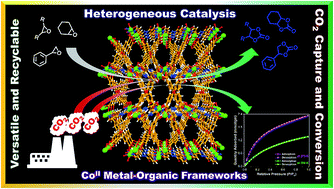Efficient catalytic conversion of terminal/internal epoxides to cyclic carbonates by porous Co(ii) MOF under ambient conditions: structure–property correlation and computational studies†
Abstract
A mixed ligand three-dimensional neutral porous framework, {[Co(OBA)(L)]xG}n (CoMOF-1) (H2OBA = 4,4′-oxybis(benzoic acid); L = (E)-N′-(pyridin-4-ylmethylene)isonicotinohydrazide; G = DMF, EtOH, MeOH, H2O), was successfully synthesized via a hydrothermal and reflux method. The activated MOF (CoMOF-1′) not only showed good affinity toward CO2 molecules, but also exhibited a good catalytic performance for CO2 conversion with a variety of terminal and internal epoxides. Grand Canonical Monte Carlo (GCMC) simulation proved the strong interactions of CO2 molecules with the amide functional groups of the MOF. The Lewis acidity of the Co(II) centers endowed by the weakly chelated carboxylate from the OBA ligand and Lewis basicity originating from the acylamide functionality of the pyridyl-based Schiff base ligand L favored the efficient solvent-free cycloaddition reaction of CO2 with different epoxides. Strikingly, CoMOF-1′ exhibited good catalytic efficiency for CO2 coupled with various terminal epoxides at ambient temperature and pressure (1 bar, 60 °C, 12 h) and with a variety of internal epoxides at moderate reaction conditions (30 bar, 100 °C, and 8 h) with good yield and recyclability. Further, the binary heterogeneous catalyst showed good chemical stability, easy separation and recyclability (6 cycles) without a noticeable decrease in activity. To the best of our knowledge, this is the first investigation on a neutral porous MOF as a potential heterogeneous solvent-free catalyst toward CO2 utilization for internal epoxide under moderate reaction conditions. Based on the structural evidence, a plausible mechanism for the cycloaddition reaction was proposed, which is further reinforced by the relative energy of each stage obtained from periodic Density Functional Theory (DFT) calculations.



 Please wait while we load your content...
Please wait while we load your content...